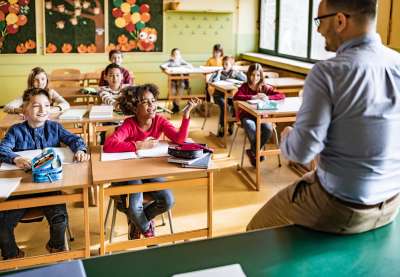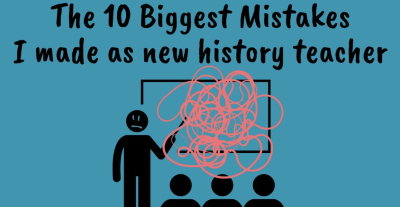Ashley Valentine is an experienced high school English teacher passionate about innovative and diverse teaching practices that fuel learning, engagement, collaboration, and fun. Here, she shares her experiences and advice for creating a deskless classroom.
Thinking about changing your classroom setup for the new school year? Read on to find out how moving to a deskless classroom can positively impact classroom management and classroom culture, and get advice for taking the leap!
Late in the summer of 2022, I engaged in an annual August ceremony well-known to teachers: classroom setup.
In thinking about the year ahead, I was really motivated to rid the space of unnecessary items. I gazed at my crusty desktop computer– the dirty keyboard, the little dust bunnies, and the snakepit of wires — and I had one thought: yuck! It was a relief to return the bundle back to the school’s technology department. With my laptop connected to my display screen on a nearby cart, I rolled out some whiteboard peel-and-stick film and gave my old built-in desk new use. I imagined myself hosting writing conferences and leaving myself reminders. Perfect!
The following day, I came in for a few more hours of work. While executing some finishing touches, a sinking feeling settled upon me. I looked out at the sea of gray tabletops and blue student chairs and immediately had all the scary visions that make a teacher’s day-to-day life challenging: the personal gaming stations atop desks, snack buffets, and crumb remnants, desk graffiti I’d have to clean, the potential for hooded sleeping heads on desks, and– a big frustration– the vision of students who’d hide their cell phones beneath their desks.
After a discussion with my principal, an innovative thinker, we radioed the custodians to “remove the desks.”
Once there were no desks, I immediately thought, “Oh no. What did I do?” which was followed by “... so much space.”
However, there wasn’t much time to think. I had to leave for the airport mere minutes after making this drastic change. Chaotic, I know.
While in flight, I researched as much as I could about deskless classrooms. It's not that they don't exist, but there aren't many. In my reading, I learned that while my initial intention was to facilitate more presence, this change would be a catalyst for a drastic shift in my instructional practices. However, my teacher’s heart told me to be brave and that both my students and I needed something else – and “something else” is exactly what we got.
Learning in a Deskless Classroom
Here are some familiar and more innovative tools and practices my students and I engaged in daily in order to enjoy more gamified, inclusive, and Gen-Z-friendly learning.
Scavenger Hunts
My high school students took to this just as much as I'd imagine a group of much younger students might. To help students preview our unit, I hid objects around the room to give them clues about what was to come. They exercised their interpretive and collaborative skills while enjoying the benefits of tactile learning.
Vertical Learning
In my classroom, I'm very fortunate to have three walls that have magnetic whiteboard space. Those vertical learning spaces have long been part of my lessons and now I've come to depend on them more than ever. Sometimes I'll jigsaw worksheet questions and write them on the whiteboards for students to answer and share. During other lessons, we'll use a magnetic tool of some kind, like a hexagon, to facilitate hexagonal thinking. The ability to stand up and move around is welcomed by students.
Ball-and-Bucket Games
I went to my local hardware store and picked up two five-gallon buckets. I labeled each one as “agree” or “disagree.” Then I numbered stress balls with a marker. Each student was assigned a numbered ball. I displayed a statement on the board and asked students to shoot their ball into the bucket that aligned with their response to that statement (either “agree” or “disagree”). If students made the ball into the bucket, I would “leave them alone,” but for students whose ball missed the bucket, I'd scoop up the balls and ask those students to clarify what they were aiming for and explain why. Students loved this one!
Muffin Tin Pong
This is a good way to gamify almost any lesson. I asked my colleagues to donate their old muffin tins and wrote questions and prompts on muffin liners or slips of paper. Students would bounce their ping pong balls into the muffin tins and answer those questions and prompts accordingly. This is great for small groups and whole-class activities.
These are just a few samples– our options are truly extensive! We’ve used block towers, cameras, and even tabletop mini golf courses to learn.
If nothing else, consider going deskless for a day or even a week!
Deskless Classroom FAQ
#1 “How do students write?”
When students need to write something, I keep clipboards in a location that they can access. For formal, sustained writing tasks, I bring students to an alternate location, like the library or another classroom.
#2 “What do colleagues say?”
My colleagues trusted my judgment. For my discipline, teaching style, and energy level, this was a good experiment and combination. After some time, some of my colleagues were inclined to borrow the space for their own classes. That was really magical.
#3 “What do parents say?”
Since the setup was in place prior to back to school night, many parents experienced the magic firsthand… and they loved it. Several parents complimented the space and said they felt very energized by the room’s setup. Amazing!
#4 “How do you prep all of these lessons?”
In a typical week, it's true that students regularly engage in a brand new lesson style that we haven't tried before. This demands a lot of my prep time, but I also aim for efficiency and intentionality by creating tools that are transferable. I also don’t create any extra pressure to keep a certain pace of innovation. If I need to print something and we have to use clipboards for a traditional lesson, that’s what we do, but I really strive against these scenarios.
When the classroom space demands more presence, it's a lot harder, and more awkward, for students to disengage. While a cafe setup might make some balk, it's had incredible implications in my classroom. Give it some thought – there's room to grow!















